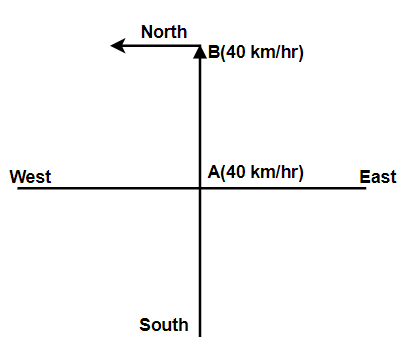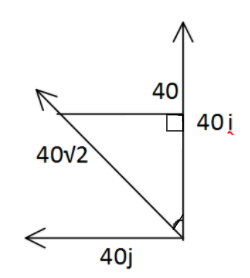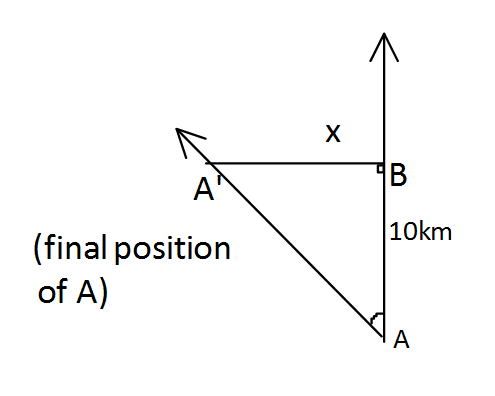Answer
369.3k+ views
Hint: Analyze the movement of both the ships using the concepts of relative motion. Draw the respective diagrams describing the motion of ship A with respect to Ship B. Trace the position of both the ships at a time $t = {t_0}$ and find the shortest distance using the concepts of vector and simple trigonometry.
Complete answer:
As we know from our intuition of kinematics that the distance between two moving points A and B is alternating either in magnitude or direction or both, each point is said to possess a velocity related to another.
Let’s understand the concept in a more practical fashion,
Suppose that B is reduced to rest then the velocity of A relative to B is the velocity with which A will appear to move towards B.
Let’s club it with the scenario which is provided to us in the given question and try doing some diagrammatic analysis.

As $fig.1$ explains that ship A is moving towards North with $40km/hr$ and ship B is moving towards west with $40km/hr$ .
Drawing vector diagram for the current scenario will look like :

Velocity of A with respect to B = ${\vec V_{AB}}$ = ${\vec V_{AG}} - {\vec V_{BG}}$
${\vec V_{AB}}$ =$40\hat j - 40\hat i$
Magnitude of \[{\overrightarrow V _{AB}}\] = $\sqrt {{{40}^2} + {{40}^2} + 2 \times 40 \times 40 \times \cos {{90}^ \circ }} $
$\left| {{{\vec V}_{AB}}} \right|$ = $\sqrt {{{40}^2} + {{40}^2}} $
$\left| {{{\vec V}_{AB}}} \right|$ = $40\sqrt 2 $ (using resultant of vectors, since angle between unit vectors is ${90^ \circ }$

$ \tan \theta = \dfrac{{40}}{{40}} = 1 \\
\theta = {\tan ^{ - 1}}1 = 45^\circ \\
$
As B is considered to be at rest, then A is moving towards B with the velocity $40$ $kmph$ and an angle of $45^\circ $ with respect to it. As stated in the question, the distance between A and B is $10km$ . The distance of closest approach is the perpendicular distance between A and B.

$
\sin \angle A'AB = \dfrac{x}{{10}} \\
\dfrac{1}{{\sqrt 2 }} = \dfrac{x}{{10}} \\
x = \dfrac{{10}}{{\sqrt 2 }}cm \\
$
Note:
To combat such types of problems one needs to trace the motion at different instances and systematically proceed with the concepts of relative motion. Always remember that signs play a crucial role in such problems. Therefore, be very careful with the mathematical operators. Proceed with the concepts of simple kinematics, vector and relative motion and the new layers would automatically start getting unfolded.
Complete answer:
As we know from our intuition of kinematics that the distance between two moving points A and B is alternating either in magnitude or direction or both, each point is said to possess a velocity related to another.
Let’s understand the concept in a more practical fashion,
Suppose that B is reduced to rest then the velocity of A relative to B is the velocity with which A will appear to move towards B.
Let’s club it with the scenario which is provided to us in the given question and try doing some diagrammatic analysis.

As $fig.1$ explains that ship A is moving towards North with $40km/hr$ and ship B is moving towards west with $40km/hr$ .
Drawing vector diagram for the current scenario will look like :

Velocity of A with respect to B = ${\vec V_{AB}}$ = ${\vec V_{AG}} - {\vec V_{BG}}$
${\vec V_{AB}}$ =$40\hat j - 40\hat i$
Magnitude of \[{\overrightarrow V _{AB}}\] = $\sqrt {{{40}^2} + {{40}^2} + 2 \times 40 \times 40 \times \cos {{90}^ \circ }} $
$\left| {{{\vec V}_{AB}}} \right|$ = $\sqrt {{{40}^2} + {{40}^2}} $
$\left| {{{\vec V}_{AB}}} \right|$ = $40\sqrt 2 $ (using resultant of vectors, since angle between unit vectors is ${90^ \circ }$

$ \tan \theta = \dfrac{{40}}{{40}} = 1 \\
\theta = {\tan ^{ - 1}}1 = 45^\circ \\
$
As B is considered to be at rest, then A is moving towards B with the velocity $40$ $kmph$ and an angle of $45^\circ $ with respect to it. As stated in the question, the distance between A and B is $10km$ . The distance of closest approach is the perpendicular distance between A and B.

$
\sin \angle A'AB = \dfrac{x}{{10}} \\
\dfrac{1}{{\sqrt 2 }} = \dfrac{x}{{10}} \\
x = \dfrac{{10}}{{\sqrt 2 }}cm \\
$
Note:
To combat such types of problems one needs to trace the motion at different instances and systematically proceed with the concepts of relative motion. Always remember that signs play a crucial role in such problems. Therefore, be very careful with the mathematical operators. Proceed with the concepts of simple kinematics, vector and relative motion and the new layers would automatically start getting unfolded.
Recently Updated Pages
Why Are Noble Gases NonReactive class 11 chemistry CBSE

Let X and Y be the sets of all positive divisors of class 11 maths CBSE

Let x and y be 2 real numbers which satisfy the equations class 11 maths CBSE

Let x 4log 2sqrt 9k 1 + 7 and y dfrac132log 2sqrt5 class 11 maths CBSE

Let x22ax+b20 and x22bx+a20 be two equations Then the class 11 maths CBSE

Let x1x2xn be in an AP of x1 + x4 + x9 + x11 + x20-class-11-maths-CBSE

Trending doubts
Which are the Top 10 Largest Countries of the World?

Fill the blanks with the suitable prepositions 1 The class 9 english CBSE

Give 10 examples for herbs , shrubs , climbers , creepers

Difference between Prokaryotic cell and Eukaryotic class 11 biology CBSE

Difference Between Plant Cell and Animal Cell

Change the following sentences into negative and interrogative class 10 english CBSE

Fill the blanks with proper collective nouns 1 A of class 10 english CBSE

Differentiate between homogeneous and heterogeneous class 12 chemistry CBSE

Select the word that is correctly spelled a Twelveth class 10 english CBSE



